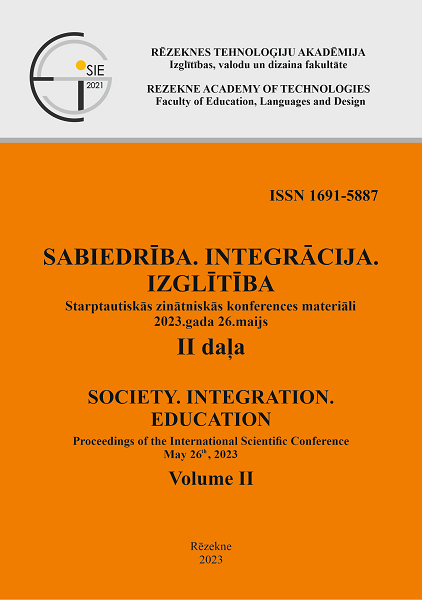ANALYSIS OF THE DYNAMICS OF PROSTATE CANCER DIAGNOSIS IN THE REGIONAL HOSPITAL DURING THE PERIOD 2018 – 2022
DOI:
https://doi.org/10.17770/sie2023vol2.7146Keywords:
biopsy, Gleason score, prostate cancer, prostate-specific antigenAbstract
Prostate cancer is a serious medical problem around the world. In many parts of the world, prostate cancer is the leading cause of morbidity and the second leading cause of death immediately after lung cancer. The largest proportion of cases of malignant prostate tumors is in men aged 60-80 years. The Latgale region has the highest proportion of seniors in the population (22.1%). The aim of this research was to evaluate the dynamics of primary diagnostic results over 5 years period in Daugavpils hospital patients. Objects of the study are 546 patients (men) aged from 47 to 88 years who had a PSA marker and prostate biopsy results (histological responses) collected in the period from 1 January 2018 until 1 July 2022. For quantitative evaluation of histological data, the Gleason score was used, as well as its derivative GRADE (degree of malignancy). To assess the dynamics of the quality of diagnostics of prostate cancer over 5 years, the correlation coefficient between the data on the Gleason score of newly diagnosed cancer and the 5 years period of the study was used. Relationships between PSA values, Gleason scores and patient age were also assessed. The SPSS data Statistics program was used for calculation. Difficulties in diagnosis in older patients were discussed.
References
Aron, M., Rajeev, T., & Gupta, N. (2000). Antibiotic prophylaxis for transrectal needle biopsy of the prostate: a randomized controlled study. BJ, 85(6), 682-5, 10759665.
Epstein, J., Allsbrook, W., Amin M. et al. (2005). The 2005 International Society of Urologic Pathology (ISUP) Consensus Conference on Gleason grading of Prostatic Carcinoma. Am J Surg Pathol, 29(9), 1228-42, 16096414.
European Association of Urologists. (2022). Prostate cancer. Retrieved from: https://uroweb.org/guideline/prostate-cancer
Hara, R., Jo, Y., Fujii, T., et al. (2008). Optimal approach for prostate cancer detection as initial biopsy: prospective randomized study comparing transperineal versus transrectal systematic 12-core biopsy. Urology, 71(2), 191-5, 18308081.
Iczkowski, K., Casella, G., Seppala, R. et al. (2002). Needle core length in sextant biopsy influences prostate cancer detection rate. Urology, 59(5), 698-703, 11992843.
Joel, A., Lantz, A. & Aly, M. (2022). Digital Rectal Examination in Stockholm3 Biomarker-based Prostate Cancer Screening, European Urology Open Science, 44, 69-75, S2666168322008771.
Latvijas Slimību profilakses un kontroles centrs. (2017). Pirmreizēji reģistrēto gadījumu skaits ar ļaundabīga audzēja diagnozi 2010.-2017. gadā. Pieejams: https://www.spkc.gov.lv/lv/search?q=prostata&page=1
Latvijas Slimību profilakses un kontroles centrs. (2020). Latvijas reģionu veselības profils 2010-2019. Pieejams: https://www.spkc.gov.lv/lv/media/5071/download?attachment
Latvijas Slimību profilakses un kontroles centrs. (2020). Veselības aprūpes pakalpojumu onkoloģijas jomā uzlabošanas plāna 2017.–2020. gadam izpilde. Pieejams: https://www.spkc.gov.lv/lv/veselibas-sistemas-darbibas-snieguma-novertejums
Lietotāja rokasgrāmata ADVIA Centaur® XPT Immunoassay System, Siemens, (REF. 10816701 Rev. A, 2014-09).
Linkon, A. H. M., Labib, M. M., Hasan, T., & Hossain, M. (2021). Deep learning in prostate cancer diagnosis and Gleason grading in histopathology images: An extensive study. Informatics in Medicine Unlocked, 24, 100582.
McMillen, M. (2022). Prostate Cancer in Older People. Retrieved from https://www.webmd.com/prostate-cancer/prostate-cancer-late-in-life-diagnosis.
Middleton, R., Thompson, I., Austenfeld, M. et al. (1995). Prostate Cancer Clinical Guidelines Panel Summary report on the management of clinically localized prostate cancer. The American Urological Association, 154(6), 2144-8, 7500479.
Moul, J. (2017). Comparison of DRE and PSA in the Detection of Prostate Cancer. The Journal of Urology. 197, 2, S208-S20, j.juro.2016.11.031.
Parker, C., Gillessen, S., Heidenreich, A., & Horwich, A. (2015). Cancer of the prostate: ESMO Clinical Practice Guidelines for diagnosis, treatment and follow-up. Annals of Oncology, 26, v69-v77.
Pron, G. (2015). Prostate-Specific Antigen (PSA)–Based Population Screening for Prostate Cancer: An Evidence-Based Analysis. Ont Health Technol Assess Ser, 5(10), 1–64, PMC4561549.
Waldron, N., Chowdhury, S., & McCahill, C. (2023). Prostate cancer. Medicine, 48-52, j.mpmed.2022.10.013.






